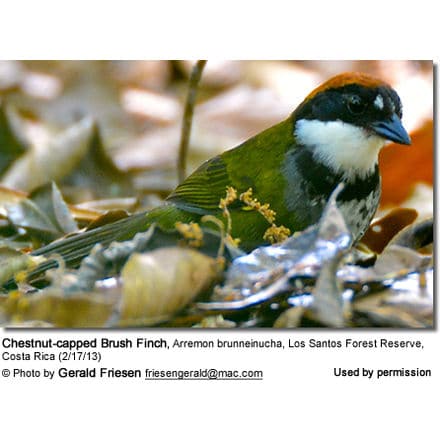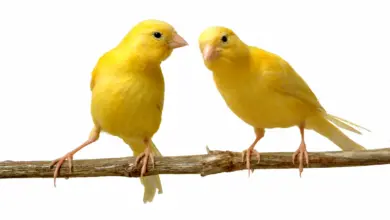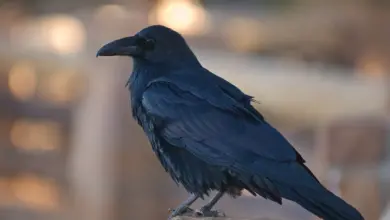Chestnut-capped Brush Finches
The Chestnut-capped Brush Finch (Arremon brunneinucha) – also known as San Martin Brush-Finches – are small colorful sparrows that occur naturally in the highlands of Mexico south throughout Middle America to southernmost Peru.
Throughout its range, this bird is most easily identified by its olive-colored upper parts, white lower parts, chestnut crown, black mask and chest band (lacking in some subspecies).

Distribution / Habitat
Chestnut-capped Brush-Finches have a natural range that stretches from southern Mexico – where they are found in the mountains of Guerrero and eastern San Luis Potosi to the south until Chiapas.
They range south through Central America to western Ecuador in South America.
They inhabit montane forests at altitudes from ~ 2,000 – 11,500 feet (600 – 3,500 meters).
Throughout their range, these birds are non-migratory (resident). Even though they are quite common within their range, they are not easily seen as they typically remain concealed in densely vegetated areas.
Subspecies and Ranges:
- Chestnut-capped Brush-Finch (Buarremon brunneinucha brunneinucha – Lafresnaye, 1839) – Nominate form
- Range: Eastern Mexico – from San Luis Potosí and Veracruz south to northeastern Oaxaca.
- Chestnut-capped Brush-Finch (suttoni) (Buarremon brunneinucha suttoni – Parkes, 1954)
- Range: Mountains of southwestern Mexico – from Guerrero east to central Oaxaca
- Chestnut-capped Brush-Finch (nigrilatera) (Buarremon brunneinucha nigrilatera – Rowley, JS, 1968)
- Range: Mountains of southern Mexico (Oaxaca)
- Chestnut-capped Brush-Finch (macrourus) (Buarremon brunneinucha macrourus – Parkes, 1954)
- Range: Mountains of southern Mexico (Chiapas) and southwestern Guatemala
- Chestnut-capped Brush-Finch (alleni) (Buarremon brunneinucha alleni – Parkes, 1954)
- Range: Mountains of northern El Salvador, Honduras and western Nicaragua
- Chestnut-capped Brush-Finch (elsae) (Buarremon brunneinucha elsae – Parkes, 1954)
- Range: Mountains of Costa Rica to western and central Panama
- Chestnut-capped Brush-Finch (frontalis) (Buarremon brunneinucha frontalis – Tschudi, 1844)
- Range: Mountains of extreme eastern Panama to Colombia, western and northern Venezuela (except in Falcón and Yaracuy) and southern Peru
- Chestnut-capped Brush-Finch (allinornatus) (Buarremon brunneinucha allinornatus – Phelps and Phelps, Jr, 1949)
- Range: Mountains of northwestern Venezuela – specifically the Sierra de San Luis (Falcón) and Sierra de Aroa (Yaracuy)
- Chestnut-capped Brush-Finch (inornatus) (Buarremon brunneinucha inornatus) Sclater and Salvin, 1879
- Range: Mountains of south central Ecuador from southwestern Chimborazo south to northwestern Azuay in the vicinity of Río Chimbo and Río Chanchan
- Chestnut-capped Brush-Finch (apertus) (Buarremon brunneinucha apertus – Wetmore, 1942)
- Range: Mexico in the Sierra de Tuxtla in southern Veracruz
Description
Size
- Length: 7.1 – 7.5 inches or 18 – 19 cm
- Weight: 1.5 – 1.6 oz (42 – 45 g)
Plumage Details / Adults
- The upperparts are dark olive, with darker wings and tail.
- Forehead and sides of head are black
- White spot in the center and on each side of forehead
- Crown and nape chestnut-rufous, bordered on each side by a yellow stripe.
- Black band separates the white central chest and the white throat
- The sides of the chest are grey
- The flanks and lower abdomen are olive-green.
- The undertail feathers are olive green.
Other Physical Details
- Long slim bill – black in the adult and brown in the juvenile
- Large feet and legs that are brown to blackish in color
Gender ID
Males and females look alike
Juvenile Description
Immature birds have sooty-black faces, sooty-brown caps, and dull brownish-olive to sooty-brown upperparts, sooty olive throats and chests. The lower bill is yellow, the upper bill is brown.
Similar Species
The Collared Towhee (Pipilo ocai) has bright green-olive upperparts; a broader black chest band and lacks the white or grey eye stripe.
Diet / Feeding
Chestnut-capped Brush-finches feed on insects, such as beetles, roaches, crickets and moths; as well as taking spiders, small centipedes, and other invertebrates. To a lesser extent, they also eat berries.
These birds are often seen alone or in family groups. At favored feeding sites, they forage in mixed species flocks.
Breeding / Nesting
The large cup nest is constructed by the female. The nest is typically placed less than 8 feet or 2.5 m up in a dense scrub or a small tree. A clutch typically consists of two white or pale blue eggs. The female alone incubates (broods) the eggs for about 12 – 14 days to hatching.
Calls / Vocalizations / Sounds
https://www.xeno-canto.org/embed.php?XC=154851&simple=1
Alternate (Global) Names
Chinese: ???? … Czech: Habije kaštanová, pipilo kaštanovotýlý … Danish: Brunkappet Kratfinke … Dutch: Bruinkapstruikgors … Finnish: Ruskoniskasirkku … French: Atlapetes à couronne chtain, Atlapetes à tête marron, Tohi à nuque brune … German: Braunkopf-Buschammer … Italian: Fringuello di macchia capocastano … Japanese: kuriboushiyabushitodo … Norwegian: Brunissekjerrspurv … Polish: zaroslak bialogardly, zaro?lak bia?ogard?y … Russian: ????????????????? ???????? … Slovak: strnádlik hnedotylový, strnádlik hnedotylý … Spanish: Atlapetes Gorra Castaña, Cerquero Coronicastaño, Gorrión-montés Collarejo, Matorralero gorricastaño, Pinzón, Saltón Cabecicastaño, Saltón Gargantillo, Saltón Gorgiblanco … Swedish: Brunryggad buskfink


